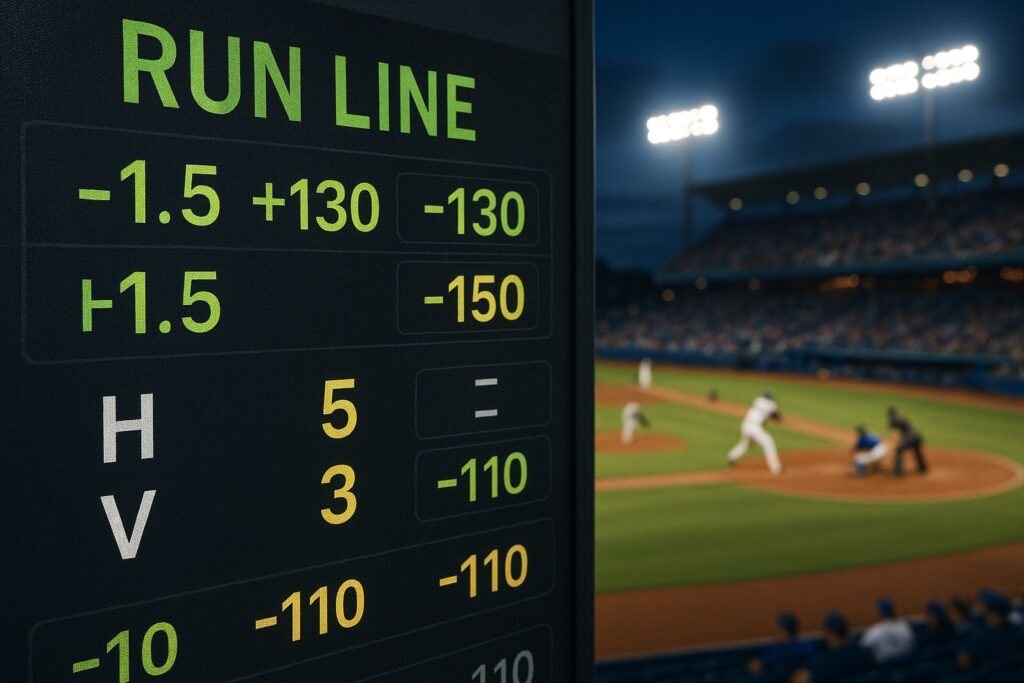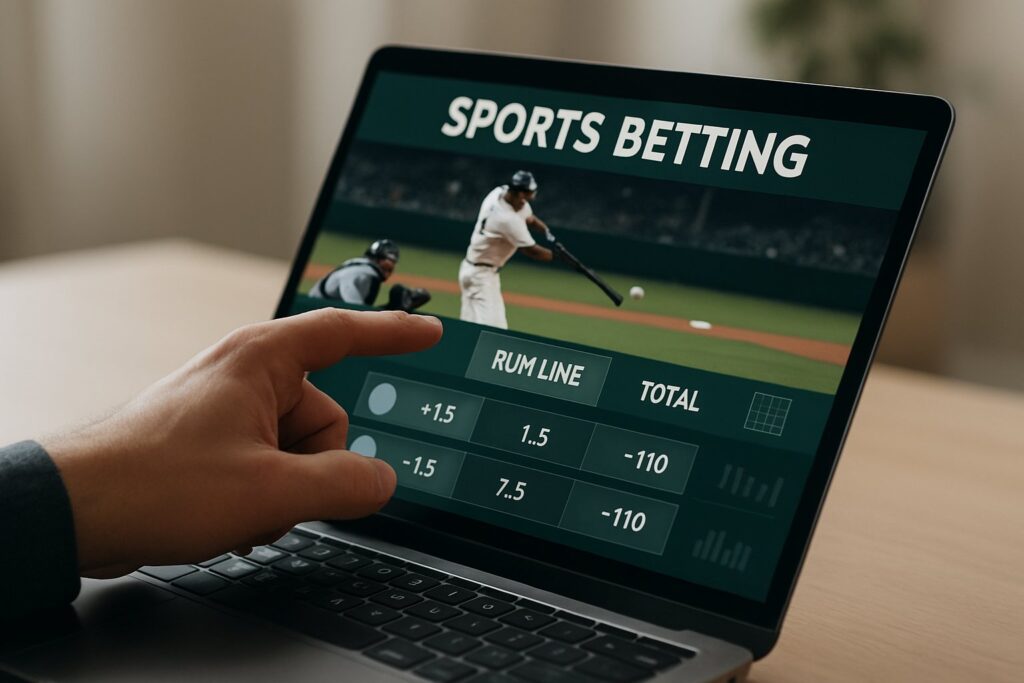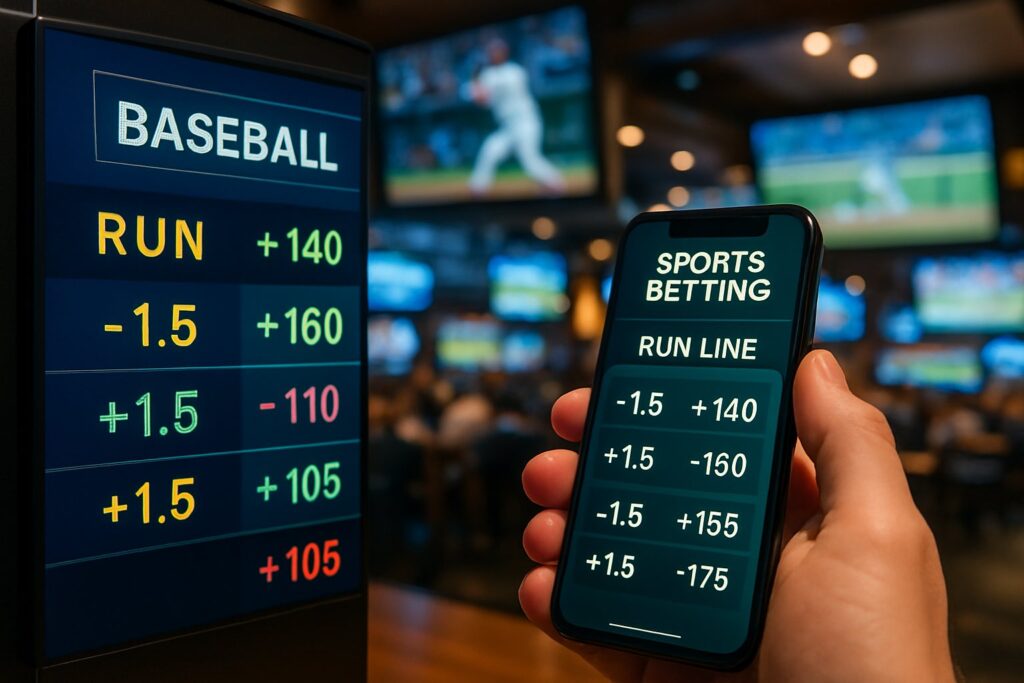by Martin Green
August 9, 2025
Last Updated on August 9, 2025 by Martin Green
If you bet on baseball, you’ll run into the term “run line” a lot. The run line is baseball’s version of a point spread, usually set at 1.5 runs, where the favorite must win by two or more runs and the underdog can lose by one run or win outright to cover. It changes how you approach a game compared to just picking the winner.

Sometimes you’ll pick the run line to get better odds on a strong favorite, or maybe you want to give an underdog a little cushion. Figuring out how it works can help you spot more value than just sticking with the moneyline. The odds – or juice, or vig, whatever you want to call it – really matter for whether the bet’s worth it.
Learning the basics is just step one. If you want to make smarter calls, you need to know how sportsbooks set the line, why odds move, and what actually affects the outcome. Once you get a feel for that, you’ll start seeing opportunities that others might overlook.

In baseball betting, the run line sets a fixed margin that changes how your wager wins or loses. It tweaks the odds by giving the underdog a head start or making the favorite win by more runs.
This method is different from just betting on which team wins, and it really changes both your risk and your payout.
The run line is basically baseball’s point spread. It’s almost always set at 1.5 runs.
If you bet the favorite at -1.5, your team has to win by two or more runs for you to win. If you go with the underdog at +1.5, they can win outright or lose by one run or less and you still win.
Run lines include extra innings unless a sportsbook says otherwise. The odds next to the run line show you what you’ll get if you win and what you have to risk. For example, +150 means you win $150 for every $100 bet, and -160 means you have to risk $160 to win $100.
Sportsbooks set the run line to balance action on both teams. They’ll shift the odds, not the spread itself, to keep things even.
In football or basketball, the point spread can swing a lot depending on the matchup. Baseball’s run line? It’s almost always stuck at 1.5 runs.
The big difference is how the odds move. With point spreads, odds usually hover around -110 on both sides. With run lines, the odds can jump all over the place depending on team strength, pitching matchups, and what the public’s betting.
Example:
| Bet Type | Spread | Odds | Win Condition |
|---|---|---|---|
| Baseball Run Line | -1.5 | +140 | Win by 2+ runs |
| Football Point Spread | -7 | -110 | Win by 8+ points |
This fixed spread in baseball means you’re usually hunting for odds value instead of waiting for the spread to move.
Run lines let you change your payout compared to the moneyline. Betting a big favorite on the moneyline sometimes means risking a lot for a tiny return. The run line gives you a better payout, but you need a bigger win.
For underdogs, the +1.5 run line gives you some protection in close games. A ton of MLB games end with a one-run difference, so if you expect a tight matchup, this can be a good play.
How well run line bets work depends on things like starting pitchers, bullpen strength, and team scoring ability. And if you shop around for the best odds at different sportsbooks, you can bump up your returns over time.

With baseball, the run line always means a 1.5-run spread. You win or lose based on whether your team covers that spread, not just if they win. This totally changes the risk and payout compared to a straight moneyline bet.
The standard run line is almost always 1.5 runs. The favorite starts at -1.5 and the underdog gets +1.5 before the game even starts.
If you bet the favorite at -1.5, they need to win by two or more runs for you to cash. If you go with the underdog at +1.5, they can win outright or lose by exactly one run and you’re good.
Sportsbooks barely ever change the 1.5 spread. Instead, they mess with the odds on each side based on team strength, pitching matchups, and betting trends. That keeps the run line consistent, but the payouts can swing a lot.
When you bet the favorite on the run line, you’re basically saying they’ll win by at least two runs. That usually pays better than the moneyline, since it’s a tougher ask.
Example:
For underdogs, the run line gives a cushion that can make them more attractive. Even really good teams drop close games, so +1.5 can hit even if your underdog loses.
But keep in mind, the underdog’s odds usually aren’t as juicy because the extra run and a half lowers your risk. Sportsbooks price that in.
Run line bets use American odds, so you see exactly what you’ll win for your stake.
Example odds:
| Team | Run Line | Odds |
|---|---|---|
| Boston Red Sox | +1.5 | -160 |
| Toronto Blue Jays | -1.5 | +160 |
At +160, a $100 bet wins $160 if the Blue Jays cover -1.5.
At -160, you have to risk $160 to win $100 if the Red Sox cover +1.5.
Sportsbooks move these odds based on how people are betting and what the numbers say about the teams. Once you lock in your bet, your payout is set by the odds at that moment, even if the line moves later.
Run line betting isn’t just about the standard -1.5 or +1.5 spread. You can tweak the margin, flip the roles, or just bet on part of the game. These options change how much risk you’re taking and what kind of payout you might see from a sportsbook.
An alternate run line lets you pick a spread that’s different from the usual 1.5 runs.
Maybe you go bigger – like -2.5 – to chase a higher payout. That means your favorite has to win by at least three runs. Or you could give the underdog more runs, like +2.5, which makes it easier to win but drops your potential return.
Sportsbooks set the odds based on the spread you choose. The tougher the challenge for your team, the better the payout. If you give them more protection, your payout shrinks.
Alternate run lines work best when you have a strong hunch about how big the win will be. They let you fine-tune your bet to match what you expect from the game.
A reverse run line flips the usual setup. The favorite receives runs instead of giving them, and the underdog has to win by more than the set margin.
So, instead of Yankees -1.5, you could take Yankees +1.5. That means the other team has to win by at least two runs for you to lose.
You can also back the underdog to cover a negative spread, like turning +1.5 into -1.5. That’s a risky move since you’re betting the underdog will win by multiple runs.
Sportsbooks pay out more for reverse run lines because they don’t hit as often. Only use this if you genuinely think the underdog is set to dominate.
A first five run line only covers the first five innings. It works kind of like a halftime spread in other sports.
The spread is usually -0.5 for the favorite and +0.5 for the underdog. If you take the favorite at -0.5, they need to be ahead after five innings. If you go with the underdog at +0.5, they can be tied or leading at that point.
This type of run line takes the bullpen out of the equation. It’s a good option if you think the starting pitcher has a clear edge. Sportsbooks post separate odds for first five run lines, so you can zero in on early-game matchups and not worry about the full game result.
Every type of MLB bet measures success a little differently. Some just care about who wins. Others depend on how big the win is or the total score. Knowing these differences helps you pick the bet that fits your style.
A moneyline bet is as straightforward as it gets. You pick which team you think will win. Odds shift based on each team’s chances, so favorites pay less and underdogs pay more.
The run line is more like a point spread. Standard run line is -1.5 for the favorite and +1.5 for the underdog.
Run line odds usually pay more for favorites and less for underdogs than the moneyline, since the run line adds a margin you have to hit.
If you want a better payout on a strong favorite, the run line can give you higher odds than the moneyline, but you’re taking on more risk.
A total bet, or over/under, doesn’t care which team wins. You’re just betting if the combined runs from both teams land over or under a given number.
Let’s say the total is 8.5. If the teams put up 9 or more runs, you win the over. If they score 8 or less, you win the under.
The total ignores the margin of victory and just tracks the game’s scoring.
Things like starting pitchers, bullpen quality, and ballpark conditions can really influence totals. The run line, though, focuses on the outcome and the run spread.
Totals can make sense if you feel confident about offense or pitching but aren’t sure who’ll win.
Run line bets rely on sportsbook house rules, and those rules can decide if your bet stands or gets refunded.
Game completion requirements and listed pitchers are probably the two biggest things to watch.
Sportsbooks need a game to reach a certain number of innings for a run line bet to count.
Most use the 9-inning rule (or 8.5 if the home team is ahead).
If bad weather, power outages, or other delays end the game before that point, your bet usually gets voided.
Even if your team is up by enough runs, it doesn’t matter – the bet won’t count.
Example:
| Bet | Score at Stoppage | Innings Played | Result |
|---|---|---|---|
| Mets -1.5 | 7–0 | 7 | Void |
| Rockies +1.5 | 3–2 | 6 | Void |
Some sportsbooks handle this a bit differently, so it’s smart to check their rules before you bet.
This matters most with outdoor stadiums, where weather can be unpredictable.
Many sportsbooks link your run line bet to the listed starting pitchers at the time you place it.
If either starter changes before the first pitch, they’ll usually cancel and refund your bet.
This protects you from big shifts in expectations.
If an ace pitcher gets scratched, the run line odds can swing a lot, changing your risk and payout.
If you want to stick with the bet after a pitching change, you’ll need to place a new wager at the updated line.
Always double-check if you’ve selected “action” or “listed pitchers” on your bet slip so you know how your sportsbook will treat changes.
To bet the run line well, you need good timing and a sense for how teams perform in certain spots. Don’t just look at win-loss records – focus on scoring margins, pitching matchups, and recent trends that actually impact the spread.
Think about betting the run line when the favorite has a strong starter and a solid bullpen. That bumps up their odds of covering a -1.5 spread.
If the favorite keeps winning by multiple runs, the run line can give you better value than the moneyline, which often pays less.
Check out home vs. away performance. Some teams just score more at home, making it easier to win by 2 or more. On the flip side, road underdogs might keep things close, so the +1.5 spread could be worth a look.
Weather matters too. Wind blowing out in certain parks can lead to more runs, which might help favorites cover bigger spreads.
When you’re backing an underdog at +1.5, look for teams that often lose by just one run or pull off close wins. Checking their run differential and how they do in one-run games can point you in the right direction.
Pitching matchups are huge. If the underdog has an ace starting, they might keep things tight and stay within reach.
A strong bullpen also helps. They can hold a small lead or keep the game from turning into a blowout, boosting your shot at winning a +1.5 bet.
It’s worth looking at past head-to-head results too. Some underdogs just match up well against certain teams and keep games close.
In baseball betting, the run line sets a fixed run margin that changes how you win or lose. It’s important to know how it stacks up against other bet types, how the odds work, and how the idea shows up in other sports.
A run line is baseball’s version of a point spread. One team gets -1.5 runs, the other gets +1.5 runs. You win if your team covers that margin.
Moneyline bets just ask you to pick the winner, no matter the score. Run line bets factor in the margin of victory or defeat, which changes the odds and how risky the bet is.
With a 1.5 run line, the favorite has to win by 2 or more. The underdog can win outright or lose by just 1 run and still cover. In standard MLB markets, this number barely ever changes.
Basketball doesn’t use the term “run line.” Instead, you get a point spread, which works similarly but the numbers are usually bigger because of higher scores. The idea’s the same – your team needs to cover the spread.
Yep. Football uses a point spread that can change a lot depending on the matchup and expected scores. Baseball’s run line is almost always ±1.5 runs. That fixed line is what makes it different from football spreads.
The odds tell you what you stand to win based on your bet. If you take a favorite at -1.5 runs, you’ll often get plus odds – a bigger payout if they cover, but it’s less likely to happen. On the other hand, backing the underdog at +1.5 usually means minus odds. You won’t win as much, but there’s a better shot they’ll keep it close enough to cover.